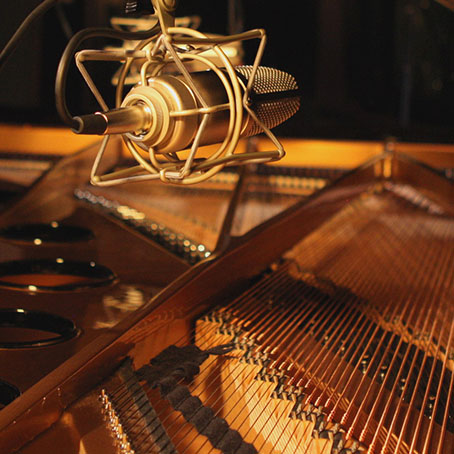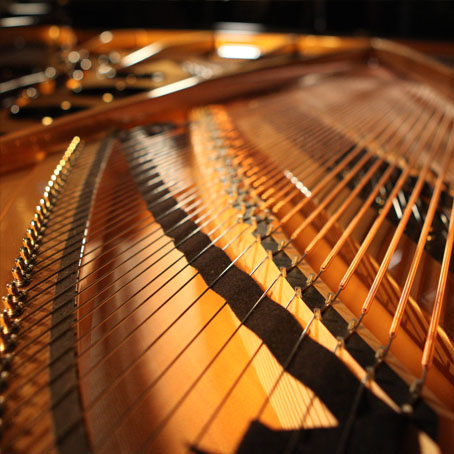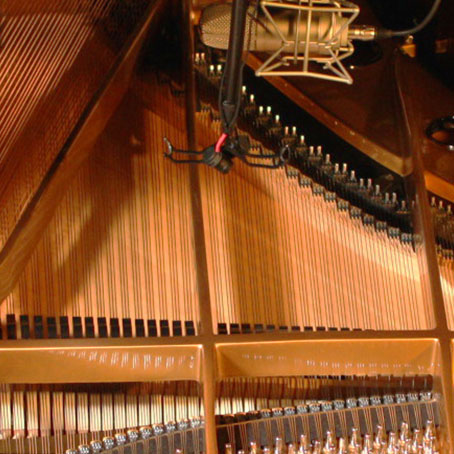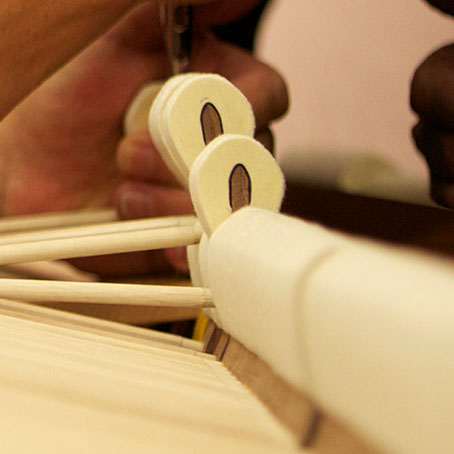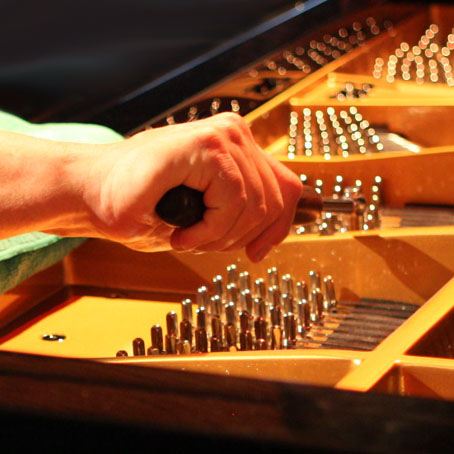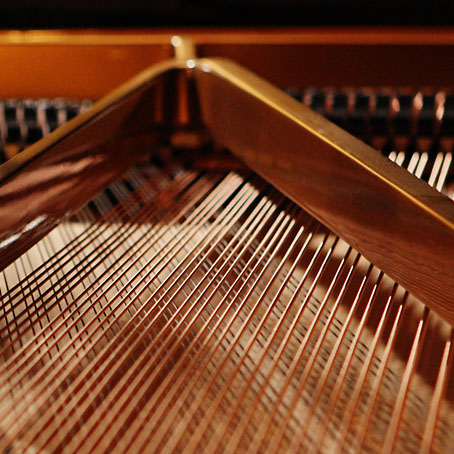'By far one of the more superior virtual pianos on the market today'
- Sample Library Review
At VI Labs we believe that some instruments truly can inspire and take your creativity to new levels. Ravenscroft 275 is one of these rare instruments. This one-of-a-kind concert grand has been recreated using nearly 17,000 samples and 4 discrete microphones, controlled from an easy to use interface. Our goal was to emulate all aspects of the 275's detailed voice using the latest sampling technology and let this amazing piano speak with clarity. The result: a virtual piano like no other.
Reproducing the tone and playability of a concert grand like the 275 Titanium is no easy task. Precise playing velocities plus complex harmonic interactions and details are carefully sampled and then controlled by a powerful script and engine. Control is similar to a modeled virtual piano but entirely sample-based. Touch response is consistent no matter the controller used. All while keeping your resource usage minimal and offering fast load times.
It's one piano that works for all styles. And gorgeous detail is abundant. Rich clear hammer attacks, unique Muted Strikes, staccato Release Trails, real sampled Una Corda pedal, and sampled Resonance all lead to a level of realism previously unobtainable in a virtual piano. If the usual piano tones have worn out their welcome and it's time for something fresh, the Ravenscroft 275 is here. This is truly a pianist's virtual piano.
|
Ravenscroft Pianos are designed and built by Michael Spreeman at his company in Scottsdale, Arizona. After working with renowned jazz pianist and composer Bob Ravenscroft on a custom performance piano built to satisfy Bob's highest demands and expressiveness, Mr. Spreeman formed Spreeman Piano Innovations to build the exclusive line of Ravenscroft Pianos, named after the composer. Each handmade Ravenscroft grand takes well over 1,000 hours to complete which is about four times that of a factory built piano, and each can be built specifically to a customer's requests or for a specific design or location.
Mr. Spreeman had been seeing trends in how a large part of the piano world was becoming digital, and realistic sampling along with ever faster computers enable acoustic piano sounds to become easier to emulate. It was imperative for Mr. Spreeman to have his signature Ravenscroft voice captured for the most accurate 'simulator' possible. VI Labs worked with Ravenscroft Pianos at every step of the process to sample their 275 Titanium and do tests so we captured the perfect tone that satisfied the virtual and acoustic instrument makers both. A priority for Ravenscroft was finding the right team to sample their piano because of the expected level of accuracy and realism. With our detailed knowledge of acoustic pianos and recording methods plus complex scripting utilizing the UVI engine, we were able to create the officially licensed Ravenscroft 275 library that truly emulates the voice of the Ravenscroft 275 concert grand. |
The Model 275 Titanium was built to be a concerto piano and have power to sing over a full orchestra but still handle the most delicate passages with ease and clarity. Sitka spruce from a 1,000 year old tree was used for the soundboard, the action is CAD optimized to be responsive and balanced to precise tolerances, and all string termination points are of solid titanium which contribute to its brilliance and long sustain. Front and rear tuned duplex scale further adds to the brilliance and sparkle. It responds with the agility of a fine sports car. And most important for the virtual instrument, tonal possibilities and depth of voicing with the Model 275 Titanium seem limitless. The bass is deep with a pronounced fundamental, the tenor is pure and rich, and the treble retains clear overtones and can be as bright as you want just in how you play without ever sounding edgy or brittle. The sustaining sound evolves beautifully over time with several notable 'blooms'. Overall there is brightness and definition but it keeps a warm quality at all times even when it's played fortissimo in any register.
According to Mr. Spreeman, "Although our sound is very clean and pure, it's also multi-dimensional. I strive for multiple layers, or demensions, of complex harmonics that can be heard, sensed, and felt without sacrificing a strong emphasis on a bold fundamental tone." |
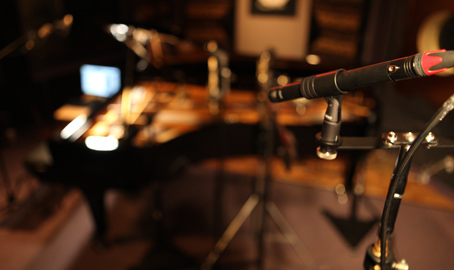
When recording a great piano in the studio, you want options. Versatility in microphone setups is needed to cover any playing style or mix without being limited to one basic tone. Plus the microphone selection and placement in and around the piano affect the stereo image and what tonal aspects of the piano are being recorded.
The four discrete phase-aligned mic setups of the Ravenscroft 275 accurately capture its unique voice in exquisite detail and can be used individually or mixed in any way. World-class mics and preamps were used throughout. Tones from close and intimate, diffuse and distant, warm or brilliant, all can be acheived with one or more of these mics. Load the samples you want and activate or deactivate mics without having to unload and reload the samples. This is the Ravenscroft 275 virtual piano studio.
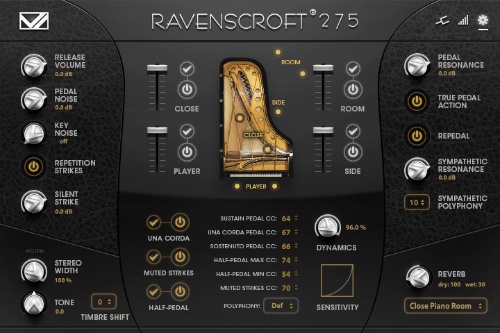
The Main control panel features the Mic selection and mixing section center stage. Loading microphones is quick and easy while memory usage remains very reasonable. Adjust the mic's volume with the slider and shut the mic off with its power switch. If a mic is loaded but deactivated by switching it off, no polyphony is used and system resources are conserved. Much time is also saved by not having to unload and reload mic samples letting you have quicker access to all the mics at once.
The microphone selection and setups were chosen for their variety of use, the character of the piano we wanted to capture as well as how they compliment one another when mixing.
CLOSE: A mix of mics inside the piano placed over the strings and hammers that capture a punchy detailed tone with a big stereo image. Great for pop/modern playing and hold up well in any mix.
PLAYER: A stereo pair of mics that capture the sound heard sitting at the keys and pick up more of the hammer attack. More distant than Close mics, they're great for classical and player's perspective while also mixing well with other mics.
SIDE: A mid-side vintage U87 setup right outside the rim that capture a balance of warmth and detail with a more focused image. Great for jazz and classical and blend well with other mics to add more room or detail. Side mics are also fully mono-capable due to the nature of mid-side.
ROOM: A mix of mics away from the piano that capture the complete instrument along with the room characteristics. Great for classical and for the unique perspective of the room sound and work great blended with any other mics.
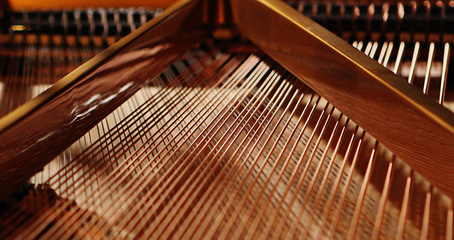
Pianists are well accustomed to the aspect known as sympathetic resonance that occurs in acoustic pianos and its importance to the sustain and how chords resolve. It binds all notes together as one instrument. Sympathetic resonance is heard among harmonically related keys held and others played, while pedal down resonance occurs as all strings vibrate together when the damper pedal is pressed adding to the overall sustain.
Both pedal down and harmonic key pedal up resonances are sample-based and not synthesized in any way. We believe this important component of the piano's tone is best emulated only with real samples. The Ravenscroft's multi-dimensional resonances have been precisely sampled and scripted for both types of advanced resonance simulations responding naturally like the real grand, all fully adjustable.
Sympathetic resonance brings all the strings together as one instrument and adds immense depth and sustain.Our resonance simulations are entirely sample-based and have been carefully matched to the actual 275 concert grand in response and volume. This is done with complex scripting made possible in the UVI engine along with accurate sampling and voicing. The end result is stunning and recreates what you would hear from the real grand while also giving you full control of the resonance samples.
A• Pedal Resonance is the unique sound of all strings vibrating in harmony when the sustain pedal is pressed down while playing. The volume of Pedal Resonance samples can be independently controlled for more or less of the effect.
B• True Pedal Action ties the Pedal Resonance samples to your sustain pedal action. A chord played with the pedal down will cause other strings to resonate, but if the sustain pedal comes up and then back down quickly, the strings will resonate again but with lower volume. This enables the sample-based Pedal Resonance to precisely work the same as it would on the acoustic grand and offers realism not possible with separate pedal-down samples.
C• Repedal allows blending and blurring of the sustained sound when the pedal is lifted and pressed down again quickly. This is a crucial component to the pedal down sustained sound which differs from anything played with the pedal up.
D• Sympathetic Resonance occurs when partials are heard in keys harmonically related to keys that are struck. Not only is this an integral part of the grand piano's tone and sustain, it's also used musically to great effect such as holding a chord and playing harmonically related to cause sympathetic resonance in the chord that's held.
E• Sympathetic Polyphony allows independent control of the number of voices allowed for the Sympathetic effect. If you're using this effect specifically and want more of it, simply increase the polyphony value. Or decrease to conserve system resources.
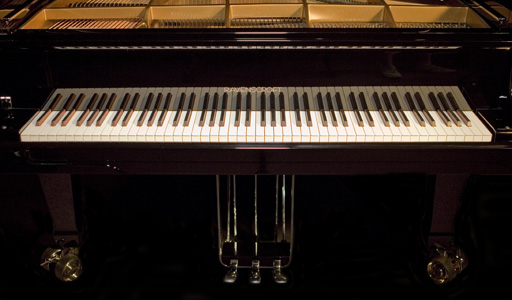
The pedals of a grand piano must be responsive and give precise control of the dampers by using the Sustain and Sostenuto pedals plus allow you to sweeten the tonal colors with the Una Corda or soft pedal. Ravenscroft 275 works with a single on/off pedal for basic sustain, or you can use all three pedals including piano-style continuous damper pedals for smooth Half-pedal control plus Sostenuto and Una Corda functions.
The Sostenuto works just like a grand piano and is perfect for triggering Sympathetic Resonance samples on notes held by this pedal. Repedal is fully supported and a crucial function to blur phrases and blend the sustained tone if the pedal is lifted and depressed quickly. Other options like half-pedal range settings and custom CC assignments for any function offer a level of control discerning pianists will appreciate.
Full control of all pedal functions happens on the main interface. All three grand piano pedals are supported with our unique True Pedal Action plus Half-pedal samples for the sustain pedal. Full Sostenuto and sampled Una Corda can be used with the center and left pedals. Repedal action is smooth and True Pedal Action creates highly realistic damper pedal resonance which works well with Half-Pedal.
• Half-Pedal: Special samples and scripting create the effect of variable damper control, so as a note is played and the damper pedal is pressed slowly, the release trail gets longer until full sustain is reached. Min and Max CC ranges for your continuous sustain pedal set the range of this effect so you can customize to your pedal and style.
• Repedal: Allows the note to continue if the sustain pedal is lifted then pressed down again quickly. A crucial feature to most pianists, this enables subtle blurring mostly in the bass and responds like a real piano without the sound fully stopping when the pedal is lifted.
• Una Corda: The soft (or shift) pedal on a grand piano making the hammers shift over not only to play one less string on most keys, but a softer part of the hammer meets the strings which results in a mellow tone with a different character. Load this discrete sample set for soft pedal which include hundreds of detailed release samples.
• True Pedal Action: Emulates the way an acoustic piano's pedal down resonance responds along with the sustain pedal being used. A chord played with the pedal down will cause other strings to resonate, but if the sustain pedal is lifted but pressed again quickly, all strings will resonate but with lower volume. In a real piano, the resonance occurs if the pedal is down when a chord is played but also if a chord is played followed by the pedal going down. The Pedal Resonance comes on when the sustain pedal is pressed and is muted when the pedal is lifted, exactly as on a real piano.
